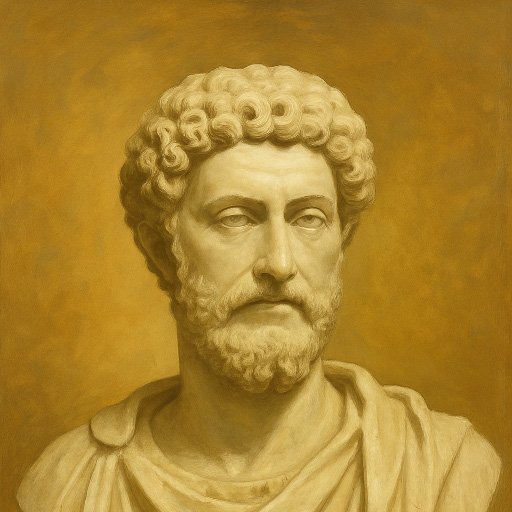Stoic Meditation: Ancient Philosophy for Modern Mental Health

A marble bust of Marcus Aurelius, the Roman Emperor and Stoic philosopher whose "Meditations" remain influential today.
Contents
- What Is Stoic Meditation?
- Stoicism's Influence on Cognitive Behavioral Therapy (CBT)
- Stoic Meditation for Depression and Anxiety Relief
- Key Stoic Practices for Mental Wellness
- Digital Tools for Stoic Practice
- Getting Started with Stoic Meditation
- FAQ: Stoic Meditation
Stoic meditation techniques are rooted in the ancient philosophy of Stoicism, yet their tools feel tailor-made for today's mental-health struggles. Imagine feeling overwhelmed by things outside your control—stoic practices for stress relief teach that peace comes from focusing on what you can control and letting go of the rest. It's a perspective shift that can be surprisingly liberating when dealing with anxiety or depression.
Instead of wrestling with every worry, you learn to respond with calm and clarity. In a world where stress and uncertainty abound, stoicism for anxiety and depression offers a grounding, no-nonsense route to emotional balance.
What Is Stoic Meditation?

Stoic meditation involves mindeful reflection on philosophical principles, including contemplation of life's impermanence.
Stoic mindfulness meditation doesn't always involve the typical eyes-closed mindfulness exercises typically associated with meditation. It's a reflective practice and mindset training drawn from Stoic philosophy. Stoicism began in ancient Greece and Rome, championed by thinkers like Epictetus, Seneca, and the emperor Marcus Aurelius. These Stoics taught practical techniques to build resilience and character.
At its core, Stoic practice means training your mind each day to distinguish between what you can change and what you can't. For example, you can't change the weather or other people's actions, but you can change your own attitudes, efforts, and responses. By deeply accepting this, you waste less energy on worrying about the uncontrollable.
Over time, this mindset can disrupt rumination that feeds depression and anxiety—much like modern CBT approaches.
Daily Stoic Meditation Practices
Stoic meditation often happens in everyday moments. In the morning, a Stoic might set intentions like, "Today I'll be honest and patient, no matter what comes." At night, they might reflect on what went well or what tested them—a personal debrief.
Some Stoics also practice negative visualization technique (*premeditatio malorum*): calmly picturing challenges or worst-case scenarios not to worry, but to prepare mentally. By envisioning a setback (missing a flight, receiving criticism) and picturing a calm response, you inoculate yourself against panic.
Early research suggests this kind of Stoic visualization reduces worry.
Stoicism's Influence on Cognitive Behavioral Therapy (CBT)

Modern psychotherapy owes a significant debt to ancient Stoic principles and practices.
Modern psychotherapy owes a quiet debt to ancient Stoics. Albert Ellis, founder of Rational-Emotive Behavior Therapy, and Aaron Beck, founder of CBT, both cited Epictetus's famous principle as a core inspiration.
Scholarly reviews trace CBT's cognitive techniques back to Stoicism and value-based action. In other words, when therapists help clients question catastrophic thinking, they're repackaging a Stoic tool.
Stoic Meditation for Depression and Anxiety Relief

Research shows stoic meditation techniques can significantly reduce worry, rumination, and anxiety symptoms.
Because stoic meditation techniques resemble CBT, it's no surprise they show similar benefits. A controlled online study found that Stoic exercises reduced worry and rumination among participants at risk for anxiety and depression.
Another community program reported gains in resilience after Stoic training.
The Neuroscience Behind Stoic Practice
Ancient philosophy for mental health also pairs naturally with mindfulness. Brain-imaging work shows that mindfulness calms brain reactivity—the brain's "alarm" center—improving emotion regulation. When Stoic meditation adds the extra step of reframing events ("It's raining; I'll make the best of it"), it can further reduce stress reactivity.
It's worth noting that stoicism for anxiety and depression isn't about suppressing feelings. Instead, you acknowledge emotions—"I feel anxious"—then decide the wisest course. Over time this reduces the intensity of distress because you're not fueling it with catastrophic self-talk.
Gratitude and Stoic Well-Being
Stoics also stress gratitude and compassion. NIH health writers note that gratitude practices lift mood and lower stress hormones. A recent meta-analysis of 64 trials confirms gratitude reduces depression.
Key Stoic Practices for Mental Wellness

Stoic meditation involves mindful reflection on philosophical principles, including contemplation of life's impermanence.
1. Focus on What You Can Control
When stress strikes, ask, "What parts of this are up to me?" Address those; release the rest. This perspective shift reduces helplessness and anchors attention on workable actions. This fundamental principle of stoic practices for stress relief helps break the cycle of worry about uncontrollable events.
2. Cognitive Distancing Exercises
The Stoic reminder "It's not events, but judgments, that upset us" teaches you to step back before reacting. Similar mindfulness techniques calm the brain.
3. Negative Visualization Technique
Periodically picture a potential setback and rehearse a calm response. Studies find this negative visualization builds resilience and moreover has direct ties to modern techniques such as exposure therapy.
4. Gratitude and Perspective Practice
Each night, note three things you're grateful for—an evidence-based mood booster. Try a "View from Above" meditation: imagine your life from a bird's-eye view; problems often shrink in proportion, easing anxiety.
5. Virtue-Based Living
Virtue-based therapy frames well-being around living with integrity, kindness, courage, and fairness. Reflecting on values provides purpose and counters the emptiness common in depression. Philosophers and psychologists alike highlight values-based living for fulfillment.
Digital Tools for Stoic Practice

Modern technology can help you integrate ancient stoic wisdom into your daily routine.
While Stoicism is an ancient practice, modern technology can make these timeless principles more accessible and consistent in your daily life. Digital tools can provide guided stoic meditations, daily reminders for reflection, and structured exercises for building resilience.
Apps that combine stoic philosophy with personalized guidance can help you:
- Practice daily morning and evening reflections
- Work through cognitive distancing exercises when stressed
- Receive reminders about focusing on what you can control
- Track your progress with gratitude and virtue-based practices
The key is finding tools that make ancient wisdom practical for modern life, helping you build the mental habits that Stoics developed through centuries of practice. For example, Wellness AI can create personalized stoic meditations tailored to your specific circumstances and philosophical interests.
Getting Started with Stoic Meditation
By weaving these habits into daily life, stoic meditation techniques become a flexible toolkit for mental health. No special gear is needed—just consistent mental practice. Over time, small shifts in focus and framing add up to a steadier, more resilient outlook.
Start with just one practice—perhaps the morning intention-setting or evening reflection. As these become natural, gradually add other elements like negative visualization technique or cognitive distancing exercises. The goal isn't perfection but progress in building mental resilience.
We can't control when the proverbial storm hits, but we can control how we steer our ship—and a Stoic hand on the tiller helps keep the voyage calm.
-Tim, Founder of Wellness AI
FAQ: Stoic Meditation
What is the difference between stoic meditation and regular meditation?
While traditional meditation often focuses on breath awareness or emptying the mind, stoic meditation is more philosophical and practical. It involves active reflection on stoic principles like focusing on what you can control, examining your judgments about events, and practicing virtue-based thinking. Stoic meditation can be done anywhere and doesn't require specific postures or breathing techniques.
Can stoic meditation help with anxiety and depression?
Yes, research shows that stoic practices can significantly help with anxiety and depression. Studies have found that even eight days of stoic exercises can reduce worry and rumination while boosting self-efficacy. Since stoic techniques influenced the development of CBT—a proven therapy for anxiety and depression—it makes sense that these ancient practices show similar benefits.
How do I practice negative visualization without making my anxiety worse?
Negative visualization (premeditatio malorum) isn't about dwelling on worst-case scenarios or catastrophizing. Instead, it's a brief, controlled exercise where you calmly imagine a potential challenge and mentally rehearse responding with wisdom and acceptance. The key is to approach it as mental preparation, not fearful worrying, and to always end by returning focus to what you can control in the present moment.
Do I need to study Stoic philosophy to practice stoic meditation?
While reading classical Stoic texts like Marcus Aurelius's "Meditations" can be helpful, it's not necessary to become a philosophy scholar. The core practices—focusing on what you can control, examining your judgments, practicing gratitude, and living according to your values—can be learned and applied immediately. Many people find these practical exercises beneficial without deep philosophical study.
How long does it take to see benefits from stoic meditation?
Some people notice immediate benefits from shifting their focus to what they can control, but lasting changes typically develop over weeks of consistent practice. Research suggests that as little as 8 days of regular stoic exercises can produce measurable improvements in worry and self-efficacy. Like any mental training, the more consistently you practice, the stronger these mental habits become.
Can I combine stoic meditation with other forms of therapy or meditation?
Absolutely. Stoic meditation complements many other approaches, including traditional mindfulness meditation, CBT, and other forms of therapy. In fact, since stoic principles influenced the development of modern cognitive-behavioral therapy, they work particularly well together. Many people find that combining stoic reflection with mindfulness practice creates a comprehensive approach to mental wellness.